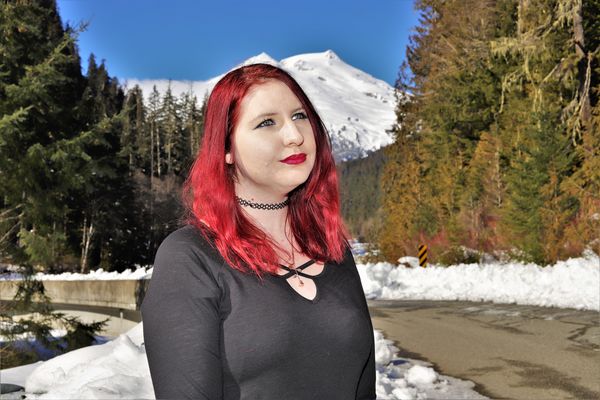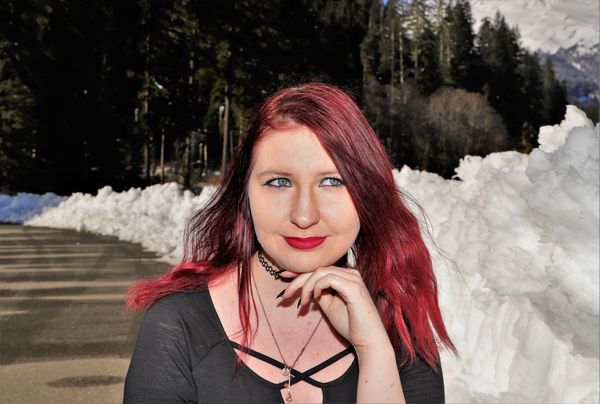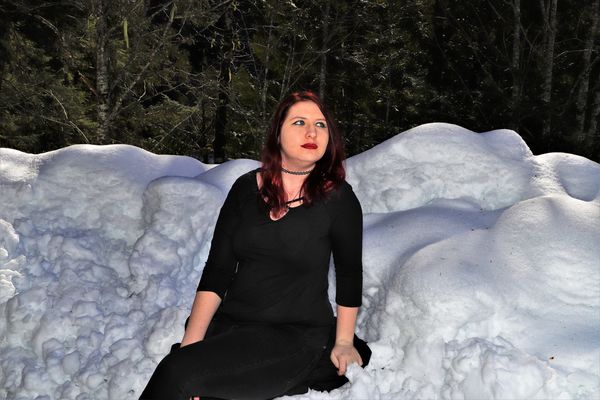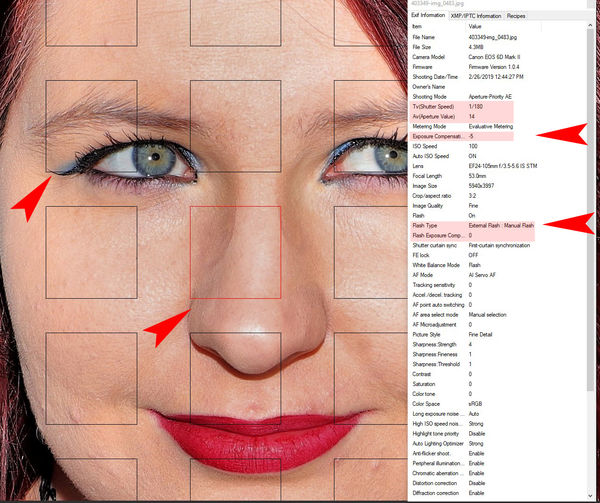getting the right exposure.
Feb 27, 2019 11:23:42 #
Its the snowy time of year here in Bellingham Washington and as most photographers want photos of the snow. Problem is getting the correct exposure, especially on a bright sunny day. I did a shoot yesterday with a friend that wanted some photos of her in the snow and for the most part feel I did ok but not great. I want to be better at my hobby and learn all that I can. I am including several photos from yesterdays shoot and asking for everyones honest opinion. Please if you feel the photo is a crappy looking photo then tell me why you feel that way so I want think your just an ass.
Gear used, Canon 6D mark ii with both a Canon 50mm 1.8 lens and a 24-105mm 3.5-5 lens. Godox TT685 speedlight. Oh and I forgot to grab the lens hood for 24-105mm from house.
Conditions were middle day, bright sunlight, 30 degrees with moderate wind chill of about 22.
Settings were Aperture Priority with speedlight set to ETTL, and making adjustments to exposure to try to keep snow from blowing off the scale.
Gear used, Canon 6D mark ii with both a Canon 50mm 1.8 lens and a 24-105mm 3.5-5 lens. Godox TT685 speedlight. Oh and I forgot to grab the lens hood for 24-105mm from house.
Conditions were middle day, bright sunlight, 30 degrees with moderate wind chill of about 22.
Settings were Aperture Priority with speedlight set to ETTL, and making adjustments to exposure to try to keep snow from blowing off the scale.
Feb 27, 2019 11:37:18 #
out4life2016 wrote:
Its the snowy time of year here in Bellingham Wash... (show quote)
What is more important, the background or the subject? Since the subject is dressed in black your task was even more difficult. Expose your subject. Snow? Easy to shoot, just over-expose by 1 or 2 stops. The flash may have caused over-exposure but that is strictly an opinion. Did your subject complain or was she satisfied? How did the lens make it to the shoot is the hood was left behind? IMHO, if the subject complained fire the one who hired you! UHH has seen lots worse. Nice job.
Feb 27, 2019 11:38:48 #
Feb 27, 2019 11:46:34 #
davidrb wrote:
What is more important, the background or the subject? Since the subject is dressed in black your task was even more difficult. Expose your subject. Snow? Easy to shoot, just over-expose by 1 or 2 stops. The flash may have caused over-exposure but that is strictly an opinion. Did your subject complain or was she satisfied? How did the lens make it to the shoot is the hood was left behind? IMHO, if the subject complained fire the one who hired you! UHH has seen lots worse. Nice job.
Thank you, the hood and filters were all left on the table since I was cleaning my gear the night before. Wasn't aware we were going to even do the shoot till 9am when she called and wanted to go. kinda last minute grab what I could and go. It does help if your more prepared. She was still happy with the shots and so far all her people like them but for me its still a learning process and can notice all the flaws.
Feb 27, 2019 11:49:34 #
jerryc41 wrote:
Yes, it is a challenge. Processing can help, though.
Thank you, Processing is something that I really need to work on. I have both lightroom and Photoshop however I hardly ever use them. These examples where just touched up using basic windows 10 program, nothing fancy. My goal is to try to get it as close as possible in the camera so I don't have to spend days on the computer editing photos.
Feb 27, 2019 12:27:46 #
You really had your work cut out for you because of the dynamic range you had to deal with. I'm no big expert but I think post processing is your only real recourse. Post is nothing to be ashamed or embarrassed about. The great film guys did plenty of darkroom work after the shot. The really successful ones even had their own darkroom specialists that they relied upon.
Please don't be offended because that is not my intention but the model's poses look pretty "canned". I'm not all that good at posing people and so I gravitate toward mostly candid shots with a short zoom lens like my 24-120. As soon as people see you with the camera to your eye they want to freeze, smile and stare at the camera. The zoom lens can sometimes help with that issue.
Please don't be offended because that is not my intention but the model's poses look pretty "canned". I'm not all that good at posing people and so I gravitate toward mostly candid shots with a short zoom lens like my 24-120. As soon as people see you with the camera to your eye they want to freeze, smile and stare at the camera. The zoom lens can sometimes help with that issue.
Feb 27, 2019 13:08:15 #
Drip Dry McFleye wrote:
You really had your work cut out for you because o... (show quote)
Thank you, and I am in no way offended. The young lady used in these photos is not a model and has an issue with relaxing. She feels very uncomfortable with here body and have had the same issue in both shoots ive used her in. Myself I am just really starting to photograph people and posing people is also a learning experience. I am finding them to be more challenging then the landscape photos I have been doing for the last 1.5 yrs.
Feb 27, 2019 13:08:41 #
IDguy
Loc: Idaho
You might want to increase the exposure or whites (if you use Lightroom) on the last two to make the snow white vs. gray. Otherwise pretty good. Using fill flash was good.
Feb 27, 2019 13:23:06 #
IDguy wrote:
You might want to increase the exposure or whites (if you use Lightroom) on the last two to make the snow white vs. gray. Otherwise pretty good. Using fill flash was good.
Thank you, this is only my second attempt using fill flash and am happy with the results and still learning. Snow is always so difficult, since there is a fine line between blowing it out and turning it grey. I will work with them today and see what I can improve on.
Feb 27, 2019 14:28:24 #
I picked one of the images to look in detail at the technical details. Viewed at 100% in DPP, we can see the details are wonderful on this image. But, the EXIF data also shows several questionable settings. We can't see from the EXIF the specific flash settings. Your Godox model supports E-TTL / E-TTL II where the flash should automatically adjust the output for the camera settings. There's many ways to achieve an exposure, I'd like to suggest a few areas to consider for practice in developing / refining your own shooting style. Rather than negative exposure compensation (-5) and a small aperture (f/14) to lower the image exposure, consider instead:
a) Assure the flash is set to E-TTL. The light in all these examples is uneven, a bit too bright or way too low. Given the exposure for the example selected, I wonder at the flash setting used for this image and whether the flash was set to E-TTL. If the "manual flash" highlighted in the screen-capture indicates manual mode on the flash, the next question would be whether the output was adjusted down from 100% output.
b) With the flash set to E-TTL and the camera set for the desired desired aperture, and the camera Exposure Compensation set back to 0, you can then use the Flash Exposure Compensation (FEC) capability of the Godox to further adjust the light output from the flash.
c) Staying in Aperture Priority, review the shutterspeed selected by the camera. The speed 1/180 of this example is fine for a seated subject, and for a non Canon flash, speed 1/180 is the basic max sync speed. This model flash supports a high-speed sync (HSS). Given the risk of subject movement, a faster shutter at 1/250 to even 1/500 would lower the risk of subject movement or camera movement for your zoom at 105mm.
d) If the flash in E-TTL and FEC doesn't achieve the desired rsult, consider too using both the camera and flash in manual mode. First adjust your camera exposure for the desired exposure, selecting specific values for aperture, shutterspeed and ISO. Depending on the desired shutterspeed, determine if HSS needs to be set on both the camera and flash to achieve the desired shutterspeed on the camera. Rather than using FEC, you can refine the flash output in + or - adjustments in 1/3-stop increments. When the flash is set to manual, you can adjust the total flash output from 100% down to a ratio of 1/128 of the max flash output.
These real-life examples you posted are a great way to learn by doing. I would add the idea of practicing at home on your own time so you're not up "on stage" learning on the fly. You mention these examples being somewhat spur of the moment. Beyond the hands-on working knowledge of the camera and flash, I suggest continuing to develop a sense of your own style and preferences for useful apertures and depth of field for your portrait work. Your 50mm will work good in the f/2.8 to f/5 range for close-ups. Consider the 24-105 zoom from f/5 to f/8 to f/11, based on the composition, assuming views from the waist-up and full-body.
Practice too moving your focus points around in preparation for the composition. The example selected for the screen capture shows the center point being used. Although you can crop later and change the position of the subject within the frame, it seems the use of the center point impacted your framing of this image. If you had instead positioned a single point along the top row of the AF array and then composed with the single AF point on her eye, you'd have less of the dead space above her head and more of her body, resulting in more options for cropping to the final result.
So, tying these suggestions together and assuming the continued use of Aperture Priority, try these steps in a practice mode, with a family member or just something around the house or maybe a pet:
1. Stand at your shooting distance to the subject, looking at the subject without the camera raised and visualize the depth of field and the position of the AF point to be used, assuming somewhere off-center.
2. Consider the aperture needed to capture the subject's face and / or body in sharp detail. Consider the background and whether you desire the background to be in detail or a pleasing out of focus blur.
3. Consider if you'll need a fill-flash to add light to the subject.
4. Prepare your camera, setting the desired aperture and AF position. If you plan to manually adjust the flash, set the flash to manual in full strength and take a test shot.
5. Adjust the camera settings such as the aperture for the different depth of field, if desired. Assuming the camera settings / composition are correct, begin to adjust the flash output. This is where practice helps where you can evaluate the histogram and highlight warnings of the test shot a judge the updates with just one or two more updates to achieve the desired exposure.
6. The flash in E-TTL is easier to use than manual, but use whatever is easier and quicker to you to achieve the desired result, whether manual on the flash or E-TTL with FEC.
a) Assure the flash is set to E-TTL. The light in all these examples is uneven, a bit too bright or way too low. Given the exposure for the example selected, I wonder at the flash setting used for this image and whether the flash was set to E-TTL. If the "manual flash" highlighted in the screen-capture indicates manual mode on the flash, the next question would be whether the output was adjusted down from 100% output.
b) With the flash set to E-TTL and the camera set for the desired desired aperture, and the camera Exposure Compensation set back to 0, you can then use the Flash Exposure Compensation (FEC) capability of the Godox to further adjust the light output from the flash.
c) Staying in Aperture Priority, review the shutterspeed selected by the camera. The speed 1/180 of this example is fine for a seated subject, and for a non Canon flash, speed 1/180 is the basic max sync speed. This model flash supports a high-speed sync (HSS). Given the risk of subject movement, a faster shutter at 1/250 to even 1/500 would lower the risk of subject movement or camera movement for your zoom at 105mm.
d) If the flash in E-TTL and FEC doesn't achieve the desired rsult, consider too using both the camera and flash in manual mode. First adjust your camera exposure for the desired exposure, selecting specific values for aperture, shutterspeed and ISO. Depending on the desired shutterspeed, determine if HSS needs to be set on both the camera and flash to achieve the desired shutterspeed on the camera. Rather than using FEC, you can refine the flash output in + or - adjustments in 1/3-stop increments. When the flash is set to manual, you can adjust the total flash output from 100% down to a ratio of 1/128 of the max flash output.
These real-life examples you posted are a great way to learn by doing. I would add the idea of practicing at home on your own time so you're not up "on stage" learning on the fly. You mention these examples being somewhat spur of the moment. Beyond the hands-on working knowledge of the camera and flash, I suggest continuing to develop a sense of your own style and preferences for useful apertures and depth of field for your portrait work. Your 50mm will work good in the f/2.8 to f/5 range for close-ups. Consider the 24-105 zoom from f/5 to f/8 to f/11, based on the composition, assuming views from the waist-up and full-body.
Practice too moving your focus points around in preparation for the composition. The example selected for the screen capture shows the center point being used. Although you can crop later and change the position of the subject within the frame, it seems the use of the center point impacted your framing of this image. If you had instead positioned a single point along the top row of the AF array and then composed with the single AF point on her eye, you'd have less of the dead space above her head and more of her body, resulting in more options for cropping to the final result.
So, tying these suggestions together and assuming the continued use of Aperture Priority, try these steps in a practice mode, with a family member or just something around the house or maybe a pet:
1. Stand at your shooting distance to the subject, looking at the subject without the camera raised and visualize the depth of field and the position of the AF point to be used, assuming somewhere off-center.
2. Consider the aperture needed to capture the subject's face and / or body in sharp detail. Consider the background and whether you desire the background to be in detail or a pleasing out of focus blur.
3. Consider if you'll need a fill-flash to add light to the subject.
4. Prepare your camera, setting the desired aperture and AF position. If you plan to manually adjust the flash, set the flash to manual in full strength and take a test shot.
5. Adjust the camera settings such as the aperture for the different depth of field, if desired. Assuming the camera settings / composition are correct, begin to adjust the flash output. This is where practice helps where you can evaluate the histogram and highlight warnings of the test shot a judge the updates with just one or two more updates to achieve the desired exposure.
6. The flash in E-TTL is easier to use than manual, but use whatever is easier and quicker to you to achieve the desired result, whether manual on the flash or E-TTL with FEC.
Feb 27, 2019 20:51:28 #
CHG_CANON wrote:
I picked one of the images to look in detail at th... (show quote)
Thank you, I am learning first to use the flash in the ETTL mode and work forward from there. The reason for shooting in Aperture Priority was because I watched a video from Adaroma TV about how to use the Flash in bright sun as a fill flash and they recommended if it was a Canon camera it being the easiest way to learn however could still be done in manual. I wanted to experiment with different depth of fields and when possible included as much of the mountain in the background. As always I appreciate your advice and always practice what you suggest. The video actually explains that you under expose the background when set at the Aperture that you desire then you set flash to ETTL and it will fire according to the Aperture that you have set inorder to properly expose the subject.
Thank you again for all you words of wisedom and great teachings.. I will be practicing this Friday when it is suppose to be sunny again with my dressed stuffed dog named Pokie that I use.
Thomas Edward.
Feb 27, 2019 21:05:05 #
For me, the practice time is many times more fun since there's less pressure. I'm not trying to contradict the Adaroma training where the idea of using Aperture priority with flash is something I've heard / followed as well. What we can't see is a video tape of your actions during this session  to see where / if some discrepancies occurred. I suspected from the small aperture the desire for the mountain. If you were as near as the example I selected but repositioned so your model had the mountain over her shoulder, you might take a sequence of images running f/5.6 to f/11 and compare the results and pick the one(s) liked best. (Like the 2nd example, now that I look at them all again.) I like mountains, but would still prefer the blue of her eyes like shown in the 100% crop ...
to see where / if some discrepancies occurred. I suspected from the small aperture the desire for the mountain. If you were as near as the example I selected but repositioned so your model had the mountain over her shoulder, you might take a sequence of images running f/5.6 to f/11 and compare the results and pick the one(s) liked best. (Like the 2nd example, now that I look at them all again.) I like mountains, but would still prefer the blue of her eyes like shown in the 100% crop ...
 to see where / if some discrepancies occurred. I suspected from the small aperture the desire for the mountain. If you were as near as the example I selected but repositioned so your model had the mountain over her shoulder, you might take a sequence of images running f/5.6 to f/11 and compare the results and pick the one(s) liked best. (Like the 2nd example, now that I look at them all again.) I like mountains, but would still prefer the blue of her eyes like shown in the 100% crop ...
to see where / if some discrepancies occurred. I suspected from the small aperture the desire for the mountain. If you were as near as the example I selected but repositioned so your model had the mountain over her shoulder, you might take a sequence of images running f/5.6 to f/11 and compare the results and pick the one(s) liked best. (Like the 2nd example, now that I look at them all again.) I like mountains, but would still prefer the blue of her eyes like shown in the 100% crop ...Feb 27, 2019 21:20:29 #
CHG_CANON wrote:
For me, the practice time is many times more fun s... (show quote)
Thank You the flash catch light was another thing I was trying to accomplish in the eyes. I am a man that likes mountians as well and one reason I spend so much time up in them but you are correct, she does have very pretty blue eyes. I hope one day to use her in a home studio that im setting up just to do Head and upper body portriats in. The mountians in the background were more for her family then myself, I would have stuck with the 50mm 1.8 prime and blurred it all if it was my choice. However I do like the ability to change my focal length without moving to much which is why I tend to change to the 24-105mm lens which I feel is a sharp lens as well.
Feb 28, 2019 13:34:40 #
I think #5 has the most natural looking pose. Would it be possible to do some more portraits of her on an overcast day where there probably won't be a need for fill flash.Portrait photos are a lot of fun and it is so nice to see that the subject is pleased with them.
Feb 28, 2019 14:35:02 #
I would have spot metered the brightest portion of the snow. Then increased exposure <*> stops. In ACR, I'd have brought the exposure slider down to normalize the histogram. Then, adjusted the white, black, highlights and shadow sliders to a reasonably close appearance of the final image. Transferred to PS and made a few more slight adjustments and that's about it.
<*> - this varies from camera to camera based on the camera's ability to capture increased exposure.
In these exposures, it appears that the model was cut and pasted into a snow scene, for some reason or other.
--Bob
<*> - this varies from camera to camera based on the camera's ability to capture increased exposure.
In these exposures, it appears that the model was cut and pasted into a snow scene, for some reason or other.
--Bob
out4life2016 wrote:
Its the snowy time of year here in Bellingham Wash... (show quote)
If you want to reply, then register here. Registration is free and your account is created instantly, so you can post right away.












